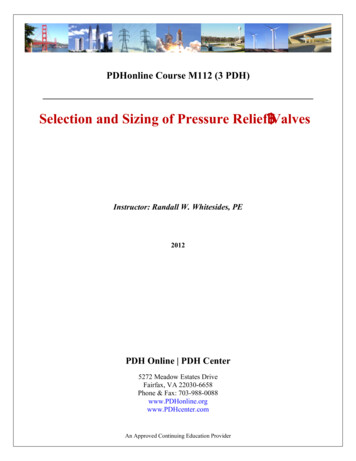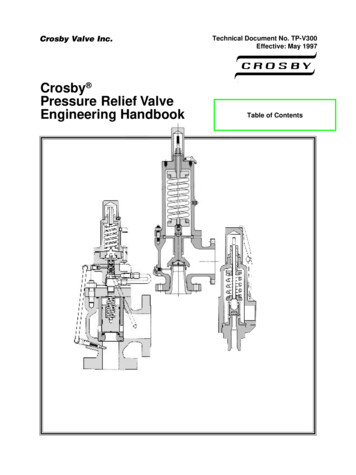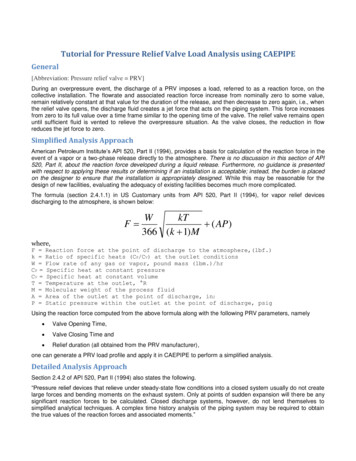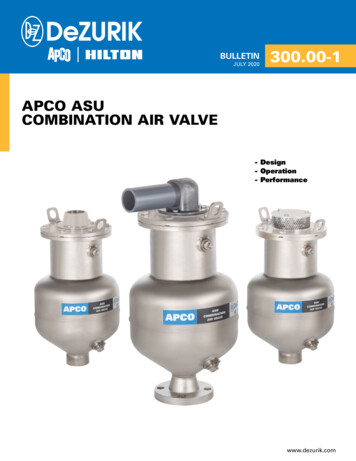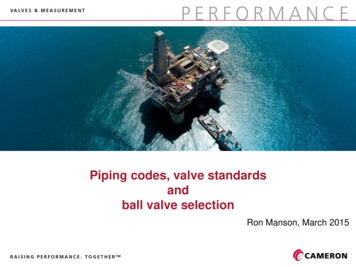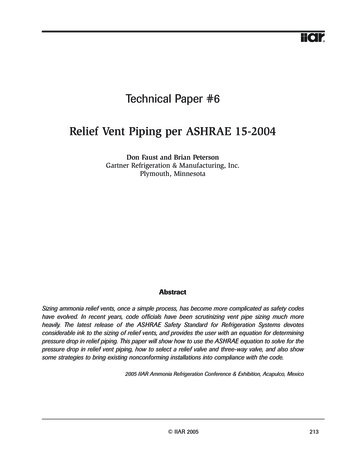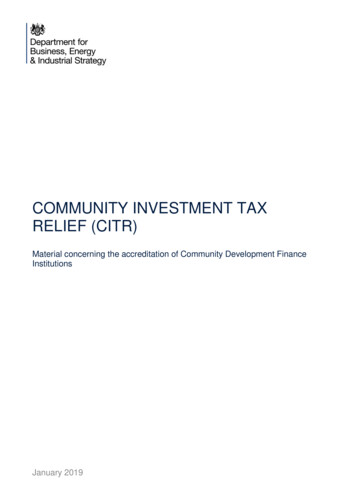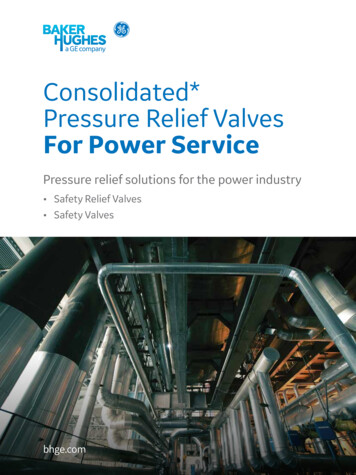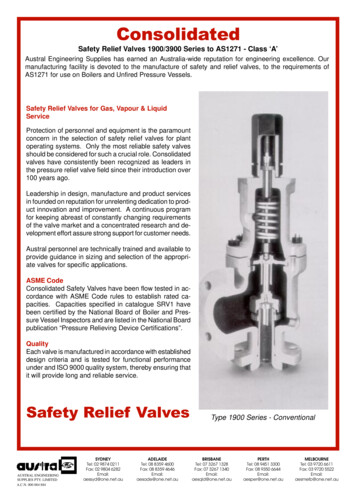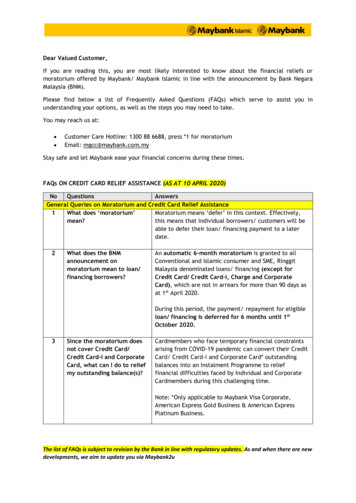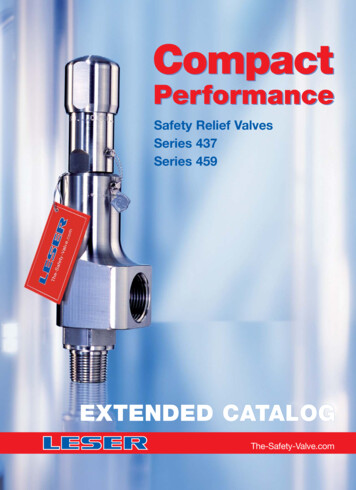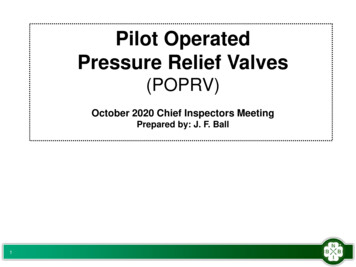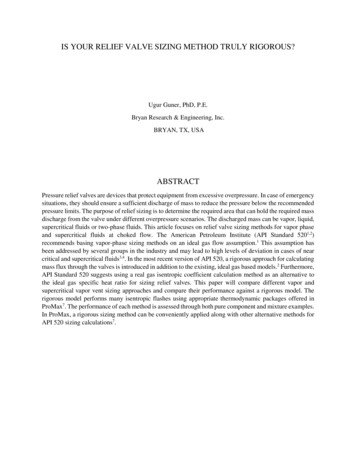
Transcription
IS YOUR RELIEF VALVE SIZING METHOD TRULY RIGOROUS?Ugur Guner, PhD, P.E.Bryan Research & Engineering, Inc.BRYAN, TX, USAABSTRACTPressure relief valves are devices that protect equipment from excessive overpressure. In case of emergencysituations, they should ensure a sufficient discharge of mass to reduce the pressure below the recommendedpressure limits. The purpose of relief sizing is to determine the required area that can hold the required massdischarge from the valve under different overpressure scenarios. The discharged mass can be vapor, liquid,supercritical fluids or two-phase fluids. This article focuses on relief valve sizing methods for vapor phaseand supercritical fluids at choked flow. The American Petroleum Institute (API Standard 5201,2)recommends basing vapor-phase sizing methods on an ideal gas flow assumption.1 This assumption hasbeen addressed by several groups in the industry and may lead to high levels of deviation in cases of nearcritical and supercritical fluids3,4. In the most recent version of API 520, a rigorous approach for calculatingmass flux through the valves is introduced in addition to the existing, ideal gas based models.2 Furthermore,API Standard 520 suggests using a real gas isentropic coefficient calculation method as an alternative tothe ideal gas specific heat ratio for sizing relief valves. This paper will compare different vapor andsupercritical vapor vent sizing approaches and compare their performance against a rigorous model. Therigorous model performs many isentropic flashes using appropriate thermodynamic packages offered inProMax7. The performance of each method is assessed through both pure component and mixture examples.In ProMax, a rigorous sizing method can be conveniently applied along with other alternative methods forAPI 520 sizing calculations7.
INTRODUCTIONPressure relief valves (PRV) are the primary means of excessive overpressure protection. A pressure reliefdevice is designed to open, relieve excessive pressure, reclose, and prevent further flow of fluid after normalconditions have been restored. PRVs consist of an inlet nozzle connected to the vessel, a movable disc thatcontrols the flow through the nozzle, and a spring that controls the position of the disc. The operation ofconventional spring loaded PRVs is based on a force balance. The spring-load is preset to apply a force thatis opposite in amount to the pressure force exerted by the fluid on the other side when it is at the set pressure.When the pressure at the inlet of the valve is below the set pressure of the valve, the disc is seated on thenozzle to prevent flow through the nozzle.The purpose of relief valve sizing is to determine the proper discharge area of the relief device and diameterof the associated inlet and outlet piping. Although an orifice is commonly used to describe the minimumflow area constricted in the valve, the geometry resembles a nozzle and area is determined by applying theequation for flow in an isentropic nozzle.5,6 The required orifice area for a relief valve is;𝐴 𝑚̇𝐾𝐷 𝐺𝑛(1),where 𝐴 is the area of the valve, 𝑚̇ is the mass flow rate through the valve, 𝐺𝑛 is the mass flux and KDis the discharge coefficient.The value of mass flow rate, 𝑚̇ is determined by energy and mass balances on the vessel under theconditions of a specific relief scenario: a run-away reaction, an external fire, loss of cooling, thermalexpansion of a liquid, control valve failure, etc. Calculation of mass flow rate discharged through the reliefsystem is not within the scope of this paper.The mass flux, 𝐺𝑛 is calculated from either an appropriate theoretical model or numerically. The dischargecoefficient 𝐾𝐷 accounts for the difference between the predicted ideal nozzle and the actual mass flux inthe valve. It is available from the valve vendors.It is important that the relief area be neither too large nor too small. An undersized valve would not providethe required overpressure protection, whereas an oversized valve will result in excessive flow. This canadversely affect the opening and closing characteristics of the relief valve, resulting in possible damage tothe valve. Unexpected high flow due to oversizing also results in undersized discharge piping and effluenthandling systems downstream of the valve. In addition, the cost of an oversized relief valve will be higher.Over predicted mass flux leads to an undersized valve, while under predicted mass flux results in anoversized valve. Hence, it is crucial to calculate mass flux correctly. In the next section, we will investigatetheoretical models for mass flux through relief valves.1
METHODSMass flux in PRVs is modeled using an isentropic nozzle equation. The expression for the mass flux (𝐺 ) inan ideal (isentropic) nozzle is obtained directly from an energy balance in the nozzle 2, 5, 6.𝑃𝑛𝐺 𝜌𝑛 𝑢𝑛 𝜌𝑛 ( 2 𝑃1𝑑𝑃)𝜌(2)where 𝑃1 is the pressure at the valve entrance, 𝑃 is the fluid pressure, 𝑃𝑛 is the downstream pressure(pressure at the nozzle exit or nozzle throat), 𝜌𝑛 is the density at the nozzle exit (throat), and 𝑢𝑛 is thevelocity at the exit.When a compressible fluid moves from a high-pressure upstream condition to a low downstream pressureacross a nozzle, orifice, or a pipe, it expands. As a result, its density decreases and velocity increases. Fora given inlet condition and with decreasing downstream pressure, the mass flux in the nozzle increases dueto the expansion and flow area reduction until a limiting velocity is reached in the nozzle. This is calledchoked or critical flow. The limiting velocity is the sonic velocity of the fluid at the throat condition. Themass flux that corresponds to the sonic velocity is known as the critical mass flux. The pressure at whichcritical mass flux occurs is called the critical flow pressure. When the downstream pressure is lower thanthe critical flow pressure, mass flux will remain constant at the maximum value.In order to solve Eq. 2 analytically, a relationship between pressure and density (or specific volume) isneeded. For vapors and gases with a constant isentropic expansion coefficient, the expression for thepressure and specific volume relationship along an isentropic path can be shown as2, 8;𝑃𝑣 𝑛 𝑃1 𝑣1𝑛(3)where 𝑃1 is the pressure at the inlet, 𝑣1 is the specific volume at the inlet, and 𝑛 is the isentropic expansioncoefficient. 𝑃 and 𝑣 are the pressure and specific volume within the isentropic path. The major assumptionsin the derivation of Eq.3 are that the gas follows an isentropic path and the isentropic coefficient is constantalong this path.Combining Eq. 2 and 3 and the definition of sonic velocity, the mass flux relation for choked flow can beobtained as;𝑛 12 𝑛 1𝐺 𝑛𝑃1 𝜌1 ()𝑛 1(4)In this equation, 𝑃1 and 𝜌1 are the inlet gas pressure and density, 𝑛 is the isentropic expansion coefficient.The expansion coefficient is assumed to be constant along the isentropic nozzle path.For gases, the density at the valve inlet can be written as8;2
𝜌1 𝑍𝑃1 𝑀𝑤𝑅𝑇1(5)where 𝑍 is the compressibility, 𝑀𝑤 is the molecular weight, 𝑇1 is the temperature at the inlet, P1 is thepressure at the inlet, and 𝑅 is the gas constant.Calculating Isentropic Expansion CoefficientsIdeal gas Specific Heat RatioIn the derivation of relief valve sizing equations, the common assumption is that the gas behaves ideallywhen following the isentropic path between upstream and downstream valve conditions. However, the inletgas density is calculated using the real gas equation (Eq. 5). An ideal gas flow assumption leads to thefollowing expression for the critical mass flux𝜅 12 𝜅 1𝐺 𝜅𝑃1 𝜌1 ()𝜅 1(6)where 𝜅 is the ideal gas isentropic coefficient and𝜅 𝐶𝑝𝑜𝐶𝑣𝑜(7)It can be seen from Eq. 7 that the ideal gas isentropic coefficient is simply equal to the ideal gas specificheat ratio. Similar to Eq. 4, the derivation of mass flux in Eq. 6 is based on the assumption that the idealgas specific heat ratio is constant along the isentropic path. Therefore, the ideal gas specific heat ratio at thevalve inlet conditions can be used.Real Gas Specific Heat RatioAPI 520 stresses that most simulators will provide the real gas specific heat ratio and that using the real gasspecific heat ratio may lead to undersized valves 2. ProMax reports both ideal gas and real gas specific heatratios. To test the impact of using real gas specific heat ratio instead of ideal gas specific heat ratio on PRVsizing, the critical mass flux based on the real gas specific heat ratio can be written as;𝑛 1𝑛 12𝐺 𝑛 𝑃1 𝜌1 ( )𝑛 1(8)Eq. 8 is simply obtained by replacing 𝜅 in Eq. 6 with 𝑛 . The term 𝑛 is the real gas specific heat ratio andis shown as𝑛 3𝐶𝑝𝐶𝑣
(9)where 𝐶𝑝 and 𝐶𝑣 are the real gas specific heat at constant pressure and volume, respectively.Real Gas Isentropic CoefficientAnother approach for calculating mass flux is to calculate the isentropic expansion coefficient for real gases.The analytical derivation for the real gas isentropic coefficient requires a valid thermodynamic model thatdescribes the pressure-volume relationship. The analytical derivation can get complicated and thecoefficient may change along the isentropic path. In the event of a constant isentropic coefficient, anexpression for the isentropic coefficient can be derived as2,4;𝑣 𝑃 𝐶𝑝𝑛 ( )𝑃 𝑣 𝑇 𝐶𝑣(10)Since the isentropic coefficient is assumed constant along the isentropic path, expression in Eq. 10 can becalculated at the valve inlet conditions. However, it is still a complex task to get an analytical expressionfor the derivative term at the right hand side of Eq. 10. It can be calculated numerically as;𝑛 𝑣1 𝛥𝑃 𝐶𝑝( )𝑃1 𝛥𝑣 𝑇 𝐶𝑣(11)where 𝛥𝑃 is the change in pressure and 𝛥𝑣 is the change in specific volume.The derivative (𝛥𝑃 𝛥𝑣) 𝑇 is calculated at inlet conditions using ProMax 7. The gas at the inlet pressure(relief pressure) 𝑃1 is expanded to a pressure; 𝑃1 𝛥𝑃. The change in pressure 𝛥𝑃 is set to a small value(10 psi used in calculations). The temperature at the outlet of the expansion process is set equal to the inlettemperature (relief temperature), 𝑇1 . Upon choosing an appropriate thermodynamic package in ProMax,flashes are performed both at the inlet (𝑃1 , 𝑇1 ) and outlet conditions ((𝑃1 𝛥𝑃), 𝑇1 ) to obtain a specificvolume change 𝛥𝑣. The real gas specific heat ratio, 𝐶𝑝 𝐶𝑣 , is calculated at the inlet flash. The calculatedreal gas isentropic coefficient can be plugged into Eq. 4 to obtain critical mass flux.Direct Integration MethodThe energy balance for an isentropic nozzle path that is given in Eq. 2 is valid irrespective of non-idealityor compressibility for any homogenous fluid. Therefore, it can be taken as the reference model forcalculating valve mass flux. This general expression can be used when the pressure-density relationship atconstant entropy is available. This relationship is not available analytically for most thermodynamicmodels. However, the integral in Eq. 2 can be evaluated numerically by direct summation over smallpressure intervals. Eq. 2 can be discretized as;1/2𝑃𝑛𝑃(𝑖 1) 𝑃(𝑖)𝐺 𝜌𝑛 ( 2 )𝜌̅𝑖𝑃1(12)4
where 𝑃(𝑖 1) and 𝑃(𝑖) are the consecutive pressures at a pressure increment, 𝜌̅𝑖 is the average density in theisentropic path between pressures: 𝑃(𝑖) and 𝑃(𝑖 1) , 𝜌𝑛 is the density at the downstream conditions, 𝑃𝑛 is thedownstream pressure. The pressure domain between valve upstream pressure 𝑃1 and valve downstreampressure 𝑃2 is divided into 𝑚 pressure steps. The step size is 𝑃(𝑖) 𝑃(𝑖) 𝑃(𝑖 1)(13)for 𝑖 0, . . , 𝑚, where𝑃(0) 𝑃1(14)and𝑃(𝑚) 𝑃𝑛(15)The step size, 𝑠, in each increment is equal to a fraction of the pressure at that step. 𝑃(𝑖) 𝑠𝑃(𝑖)(16)In this equation, 𝑠 is set to 0.05. Average density is taken as the arithmetic average of the two densities.𝜌̅𝑖 𝜌𝑖 𝜌𝑖 12(17)These calculations are performed in ProMax. First, a valid thermodynamic package for the system ischosen. Then, fluid is flashed at each pressure increment and inlet entropy using the chosen thermodynamicenvironment. Pressure, average density and outlet density resulting from the flash calculations at eachincrement are plugged into Eq. 12 and summed over all 𝑚 steps to evaluate integration. The only errorassociated with this technique is related to the numerical error that is introduced due to the discretization.Error can be reduced by choosing smaller step size (by decreasing the parameter, 𝑠) at the expense ofincreased computation load.COMPARISONIn the previous section, different theoretical models for evaluating mass flux for relief valves are presented.Direct integration is the most general, rigorous and accurate method, as it deals with real gasses and doesnot require an assumption of a constant isentropic coefficient. Hence, it can be used as a reference modelfor mass flux calculations. The other models are benchmarked against the direct integration method indifferent case studies to assess validity of assumptions in these models.5
The methods are compared based on the percent deviation of the calculated mass flux from the rigorousdirect integration method mass flux calculation for different systems at various inlet reduced pressures.Inlet reduced pressure is the ratio of inlet pressure to the critical pressure of the gas. Critical pressure is thepressure at the thermodynamic critical point of the substances above which substances cannot be liquefied.Critical pressure should not be confused with the critical flow pressure that defines the downstream pressureat which flow becomes choked. Inlet reduced critical flow ratio is defined as;𝑟 𝑃1𝑃𝑐(18)where 𝑃𝑐 is the critical pressure determined using ProMax.Percent deviation of the mass flux is defined as𝑒 100 𝐺 𝐺 𝐺 (19)where 𝑒 is the percent mass flux deviation of a method from the direct integration method. The term 𝐺 isthe mass flux calculated using the direct integration method, and 𝐺 is the mass flux calculation in question.The mass flux calculation methods have been compared with the direct integration method
API 520 sizing calculations7. 1 INTRODUCTION Pressure relief valves (PRV) are the primary means of excessive overpressure protection. A pressure relief device is designed to open, relieve excessive pressure, reclose, and prevent further flow of fluid after normal conditions have been restored. PRVs consist of an inlet nozzle connected to the vessel, a movable disc that controls the flow .
